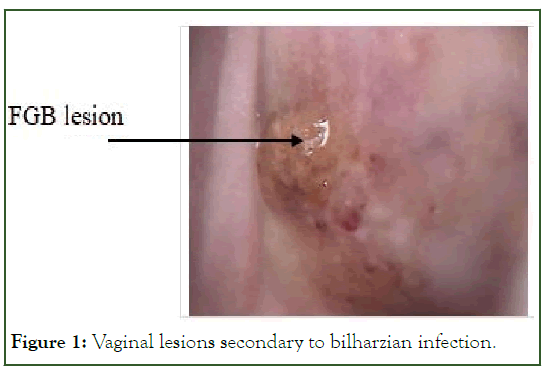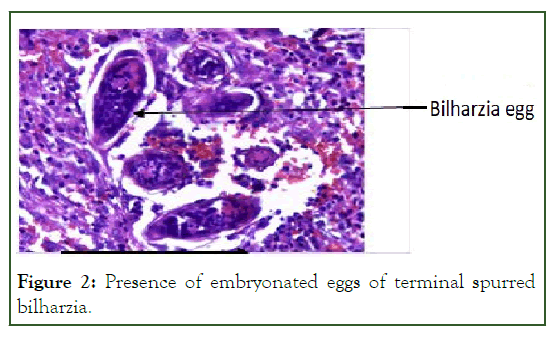Indexed In
- Genamics JournalSeek
- RefSeek
- Hamdard University
- EBSCO A-Z
- Publons
- Geneva Foundation for Medical Education and Research
- Euro Pub
- Google Scholar
Useful Links
Share This Page
Journal Flyer

Open Access Journals
- Agri and Aquaculture
- Biochemistry
- Bioinformatics & Systems Biology
- Business & Management
- Chemistry
- Clinical Sciences
- Engineering
- Food & Nutrition
- General Science
- Genetics & Molecular Biology
- Immunology & Microbiology
- Medical Sciences
- Neuroscience & Psychology
- Nursing & Health Care
- Pharmaceutical Sciences
Brief Report - (2023) Volume 20, Issue 6
The Prevalence of Female Genital Bilharziasis (FGB) in the Northern Region of Senegal
Ousmane Thiam1*, Maimouna Ndour2, Doudou Sow3, Dibor Niang4, Cherif Cheikh Tourade Sarr3, Djibrl Bahaid Sow3 and Mamoune Ndiaye32Department of Physician, Saint-Louis Regional Hospital, Saint-Louis, Senegal
3Department of Parasitology, Gaston Berger University, Saint-Louis, Senegal
4Department of Anatomy and Pathology, Gaston Berger University, Saint-Louis, Senegal
Received: 05-Jun-2023, Manuscript No. CMCH-23-21714; Editor assigned: 07-Jun-2023, Pre QC No. CMCH-23-21714 (PQ); Reviewed: 21-Jun-2023, QC No. CMCH-23-21714; Revised: 28-Jun-2023, Manuscript No. CMCH-23-21714 (R); Published: 05-Jul-2023, DOI: 10.35248/2090-7214.23.20.469
Abstract
Introduction: Female Genital Bilharzia (FGB) is pathology secondary to infection by Schistosoma haematobium. It is one of the neglected tropical diseases, capable of causing infertility, difficulties in childbirth and even cervical cancer. It represents a real public health problem. We therefore conducted a study in the maternity ward of the Saint-Louis Regional Hospital, with the overall aim of determining the prevalence of FBG in patients undergoing colposcopy. The specific objectives were to define the patient profile, and to compare colposcopic images with the World Health Organization (WHO) atlas.
Methodology: We conducted a descriptive, analytical cross-sectional study of all colposcopic images taken at the maternity ward of the Saint-Louis Regional Hospital from August 1, 2018, to September 30, 2020, i.e. 25 months. The images were compared with the FBG images described in the WHO atlas.
Results: We collected 178 colposcopy images. FGB images numbered 50%, or 28%. The mean age of the patients was 44.5 years ± 11.4 at the extremes of 18 and 78 years. Mean gestational age was 4.69-2.72. Among patients with a bilharzian lesion on the cervix, Visual Acid Inspection (VIA) was negative in 60% of cases (p=0.007, OR=3.6 (1.49-9.07)).
Conclusion: The results of our study show that FBG is a reality in our daily practice. It occurs in adult, multigestating, non-occupational women whose examination reveals a negative VIA. Healthcare providers therefore need to be trained in the recognition of lesions associated with genital bilharzias is, and public awareness needs to be raised.
Keywords
Female Genital Bilharziasis (FGB); Colposcopy; Saint-Louis; Visual Acid Inspection (VIA)
Introduction
Female Genital Bilharzia (FGB) is a condition that arises as a result of Schistosoma haematobium infection, classified as one of the neglected tropical diseases. This ailment poses a significant public health challenge as it can lead to infertility, complications during childbirth, and potentially even cervical cancer. At least 261 million people require treatment for schistosomiasis, and up to 659 million people are at risk. Senegal has had a bilharzia control program since 1999 [1-6]. In contrast to the scarcity of data on genital bilharziasis, data are available on urinary and urinary bilharziasis. In order to assess the frequency of Female Genital Bilharzia (FGB) among individuals undergoing colposcopy, our study was carried out within the maternity ward of Saint-Louis Regional Hospital. Our primary objective was to determine the prevalence of FGB, while our secondary objectives included characterizing the patient profile and comparing colposcopy images with the reference WHO atlas.
Methodology
Type of study: We conducted a cross-sectional study with an analytical focus, spanning duration of 25 months from August 1, 2018, to September 30, 2020. The setting was the unit for diagnosis and management of precancerous lesions of the uterine cervix, the Laboratory for Application and Research in Health Sciences (LARESS), the anatomy and pathology department of the Saint-Louis regional hospital and the molecular biology laboratory of the training and research unit in health sciences of the Gaston Berger University of Saint-Louis. Reading was carried out by a senior gynecologist-obstetrician.
Study population: All women who underwent colposcopy at the diagnostic unit for precancerous cervical lesions at the maternity ward of the Saint-Louis Regional Hospital in Senegal.
Sampling: We have an exhaustive census of all colposcopy cases.
Inclusion criteria: Genitally active women living in the northern zone of Senegal, with a completed colposcopy form.
Non-inclusion criteria: Patient refusing to participate in the study. Images were compared with those in the WHO atlas.
Treatment of variables: For each qualitative variable, we calculated its relative frequency and 95% Confidence Interval (CI). For quantitative variables, we analyzed the normality of the distribution. In the case of a normal distribution, the mean and standard deviation are calculated. In the case of an abnormal distribution, we calculate the median surrounded by the extremes. Quantitative variables are compared using the 2 test, while qualitative and quantitative variables are compared using the Student's t test. The significance threshold is set at 0.05. Where there is a link between two variables, the p-value is calculated, as is the strength of the link using the Odd Ratio (OR).
Results
Prevalence of Female Genital Bilharziasis (FGB)
A total of 178 laparoscopic images were collected and compared to the images in the WHO atlas. Among them, 50 images were associated with FGB, indicating a prevalence rate of 28%.
Socio-demographic characteristics
Table 1 shows the socio-demographic characteristics of patients with FGB lesions. The mean age of the patients was 42.6 ± 11.3, mean gestite 4.98 ± 2.68. No resource-generating activity was present in 64%. Patients were active in 67% of cases.
| Parameters | Presence of lesions | No lesions | P value |
|---|---|---|---|
| Age | 42.6 ± 11.3 | 45.3 ± 11.4 | 0.16 |
| Gestite | 4.98 ± 2.68 | 4.57 ± 2.73 | 0.3 |
| Parity | 4.48 ± 2.58 | 4.23 ± 2.65 | 0.58 |
| Profession | |||
| Without | 32(64%) | 87(71%) | 0.3 |
| With | 18(36%) | 34(28.1%) | |
| Genital activity | |||
| Genital activity | 32(67%) | 75(67%) | 0.9 |
| Menopausal | 16(33%) | 37(33%) | |
Table 1: Socio-demographic characteristics of patients.
Symptoms prior to colposcopy were dominated by Leucorrhoea in 57% of cases, Spontaneous metrorrhagia or after contact in 20% of cases, Pelvic pain in 10% of cases, Cervical tumors in 3% of cases.
Visual inspection: Visual inspection with acetic acid was positive in 32 patients, i.e. 64% of cases.
Colposcopic aspects: The laparoscopic images found were dominated by sand-grain aspects (38%). These included rubbery images, irregular blood vessels and yellow spots.
Anatomical-pathological aspects: Figure 1 shows the results of a biopsy of a vaginal mass. Figure 2 shows the presence of embryonated eggs of terminal spurred bilharzia. A biopsy of a genital tumor in the vagina revealed bilharzia eggs in terminal spur.

Figure 1: Vaginal lesions secondary to bilharzian infection.

Figure 2: Presence of embryonated eggs of terminal spurred bilharzia.
Discussion
In our study, the prevalence of FBG was 28%. The northern region of Senegal is marked by a high endemicity of bilharzia. In Zambia, A. Sturt found a 38.5% frequency of FBG lesions in colposcopic examinations [7].
In our study, the profile was that of a woman, with an average age of 42 and no income-generating activity. This profile is encountered in the bilharzia-endemic country of Mali by Fachinan [8], Poggensee G in Tanzanie [9].
To facilitate visual diagnosis of female genital lesions secondary to bilharzia, the WHO Atlas is an indispensable, accessible and reproducible tool, an alternative to biopsy. Comparison of the images enabled us to note the presence of 50 cases of FBG lesions, with a predominance of sand-grain aspects. These data were also found by Kjetland in Zimbawe in 2005 [10,11].
As colposcopy is not available at all levels of the health pyramid in Senegal, visual inspection was used to detect a positive result, a finding corroborated by the African literature. In Mali, Fachinan found that 85.4% of Visual Inspection with Acetic Acid (VIA) tests was positive [8].
Conclusion
In the light of these observations, we can affirm that FBG is a reality in our practice. It occurs in young women with multiple gestations. Laparoscopic findings are dominated by sand grain or sandy plaque images. Reproductive health care providers know little about it.
We therefore recommend that providers (nurses, midwives, gynecologists) be guided in its detection, that colposcopic images be rigorously analyzed, and that the authorities and the community be made aware of this pathology. In the future, the link between female genital cancers and bilharzian lesions should be investigated.
Conflicts of Interest
The authors declare that they have no conflict of interest.
Author Contributions
Ousmane Thiam: Image reading; Maimouna Ndour: Data collection, Doudou Sow: Biological analysis of results; Dibor Niang: Anatomical pathological analysis of biopsies; Cherif Cheikh Tourade Sarr, Djibrl Bahaid Sow; Mamoune Ndiaye: Review of colposcopy images.
References
- World Health Organization. Female genital schistosomiasis: a pocket atlas for clinical health-care professionals. 2015:52.
- Nouhou H, Seve B, Idi N, Moussa F. Schistosomiasis of the female genital tract: anatomoclinical and histopathological aspects. Apropos of 26 cases. Bull Soc Pathol Exot. 1998;91(3):221-223.
[Google Scholar] [PubMed]
- Bayo S, Mamantou P, Samassekou M. La bilharziose du col de l’utérus au Mali. Afr Méd. 1980;19:251-256.
- Desroches A, Lepere Jf, Moubayed P. Bilharziose Et Cancer Du Col Utérin: Étude Morphologique Et Épidémiologique De 6778 Biopsies Cervicales Répertoriées Au Chu De Dar-Es-Salam (Tanzanie). J Gynecol Obstet Biol Reprod, 1993;22:899.
- Gouzouv A, Baldassini B, Opa JF. Aspect anatomo-pathologique de la bilharziose génitale de la femme. Med Trop. 1984;44(4):331-337.
[Google Scholar] [PubMed]
- Menye PA, Serafino X, Quenum C, Camara M. Bilharziasis and cancer of the cervix uteri. Bull Soc Med Afr Noire Lang Fr. 1965;10(3):326-332.
[Google Scholar] [PubMed]
- Sturt A, Bristowe H, Webb E, Hansingo I, Phiri C, Mudenda M, et al. Visual diagnosis of female genital schistosomiasis in Zambian women from hand-held colposcopy: agreement of expert image review. Wellcome Open Res. 2023;8(14):14.
[Crossref] [Google Scholar] [PubMed]
- Fanchinan KL. Chistosomiasis and pathologies of the cervix: About 41 cases. Theses of State doctorate in medicine, Mali. 2010;92p.
- Poggensee G. Female genital schistosomiasis of the lower genital tract: prevalence and disease-associated morbidity in Northern Tanzania. J Infect Dis. 2000;181(3):1210-1213.
[Crossref] [Google Scholar] [PubMed]
- E F Kjetland. Symptoms of gynaecological Schistosoma haematobium. Trop Med Int Health. 2008;13(12):1509-1517.
[Crossref] [Google Scholar] [PubMed]
- Kjetland EF, Ndhlovu PD, Mduluza T, Gomo E, Gwanzura L, Mason PR, et al. Simple clinical manifestations of genital Schistosoma haematobium infection in rural Zimbabwean women. Am J Trop Med Hyg, 2005;72(3):311-319.
[Crossref] [Google Scholar] [PubMed]
Citation: Thiam O, Ndour M, Sow D, Niang D, Sarr CCT, Sow DB, et al. (2023) The Prevalence of Female Genital Bilharziasis (FGB) in the Northern Region of Senegal. Clinics Mother Child Health. 20:469.
Copyright: © 2023 Thiam O, et al. This is an open access article distributed under the terms of the Creative Commons Attribution License, which permits unrestricted use, distribution, and reproduction in any medium, provided the original author and source are credited.

